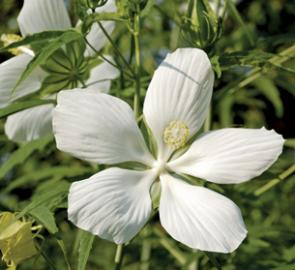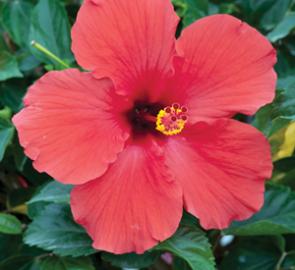Hibiscus-Perennial or Tropical?
The genus “Hibiscus” refers to both Tropical and non-tropical Hibiscus varieties. There are noticeable differences between the two types. Tropical Hibiscus are non-hardy varieties that will not survive our winter temperatures and therefore they are treated as annuals in our area. The Tropical Hibiscus has vibrant blooms in pink, white, yellow, orange and red blooms complemented with dark deep-green foliage. Perennial Hibiscus are sometimes referred to as “Hardy Hibiscus” because of their ability to over winter and re-grow each spring from an existing root system. The Perennial Hibiscus has noticeably larger blooms in muted colors of red, pink, white and bicolor combinations with a lighter pale green foliage.
Trade Wind Tropical Hibiscus (Hibiscus rosa-senensis)

The Trade Wind Hibiscus is a hybrid variety of the Tropical Hibiscus that offers the sameshowy flowers and beautiful foliage as the regular Tropical Hibiscus only on a more compact plant. Trade Wind Hibiscus has been bred to bloom continuously throughout the spring and summer seasons. This hybrid variety comes in yellow, pink, red and other assorted colors. This compact hibiscus are excellent for patios, porches and containers as well as in the landscape. They thrive in sunny locations and handle the Texas heat well. They are best planted in well-drained slightly acidic soil. Trade Wind Hibiscus do not need excessive amounts of fertilizer but an occasional application of high Nitrogen (N) fertilizer will keep them healthy and promote the desired bloom production. Trade Wind Hibiscus are Tropical so the will not tolerate the winter temperatures. Because of the Trade Winds compact size they can be brought indoors and placed near a south-facing window during the winter months to be enjoyed until spring returns.
Perennial/Hardy Hibiscus: (Hibiscus moscheutos)

Texas Star Hardy Hibiscus
Perennial Hibiscus come back year after year and bloom from mid summer through the early fall. They come in many colors with bloom sizes ranging from 6” to 12” wide. These perennials require average water so it’s best to keep them evenly moist! Do not let them dry completely between watering! To keep them healthy and encourage blooming throughout the season fertilize them regularly with a high Phosphorus (P) fertilizer (this is the 2nd number on fertilizer containers) and stop feeding after June so the excess Nitrogen (N) does not slow flower production. Plant in full to part sun, the more sun they receive the better bloom production you will be rewarded with. The average height is between 4’and 6’ tall and “24 to 36” wide. In preparation for the winter months, just before the first frost cut them back to about 6” above the ground.
Tropical Hibiscus: (Hibiscus rosa-senensis)

Tropical Hibiscus is well known for its bright showy flowers in many colors along with their glossy leaves. Hibiscus will bloom from mid spring through fall. Although suited for more tropical regions they are well adapted to our Texas heat. Tropical Hibiscus can be used in landscapes, pots or containers. This type of Hibiscus can grow to heights upwards of 15’ tall but most average 5’ to 6’ tall. The blooms on most average 4” to 6” wide. Tropical Hibiscus does best in slightly acidic well-drained soil. It prefers to be planted in full sun although it will tolerate part sun. Too little sun will result in leggy plants with less bloom production. This type of Hibiscus is very drought tolerant and does not require large amounts of water. Tropical Hibiscus do not need excessive amounts of fertilizer but an occasional application of high Nitrogen (N) fertilizer will keep them healthy and promote the desired bloom production.




